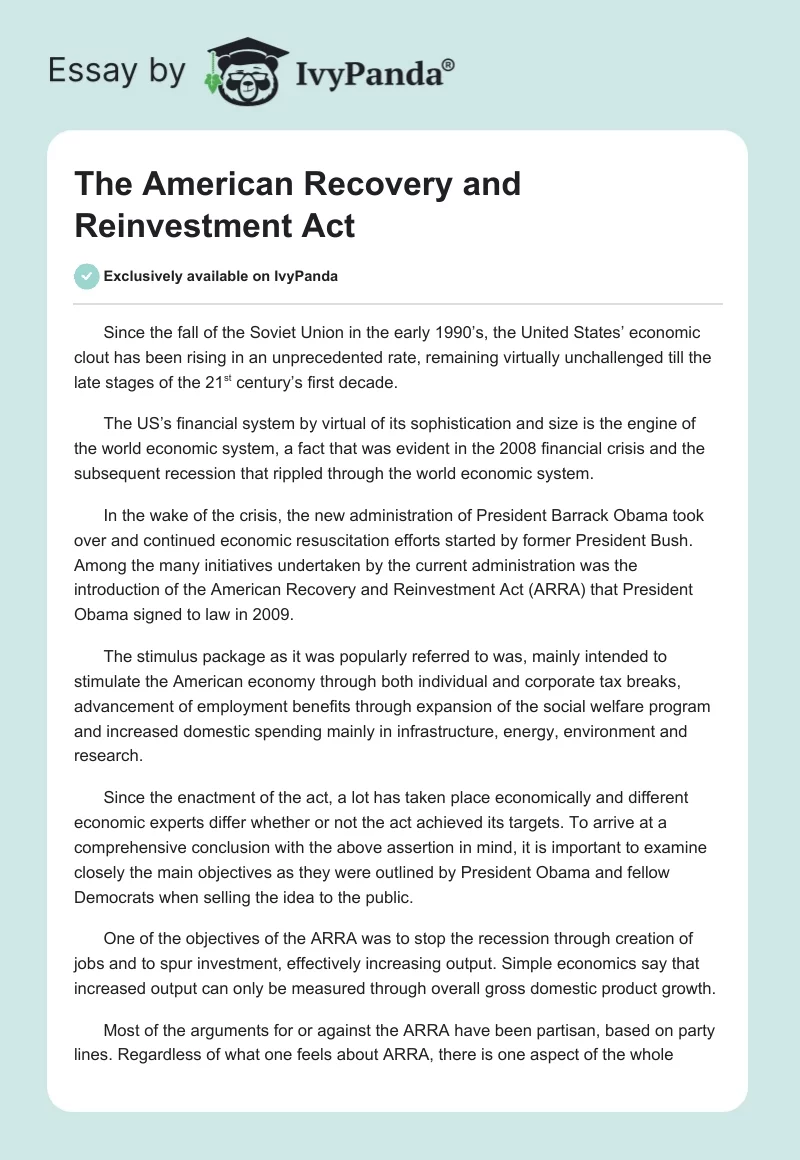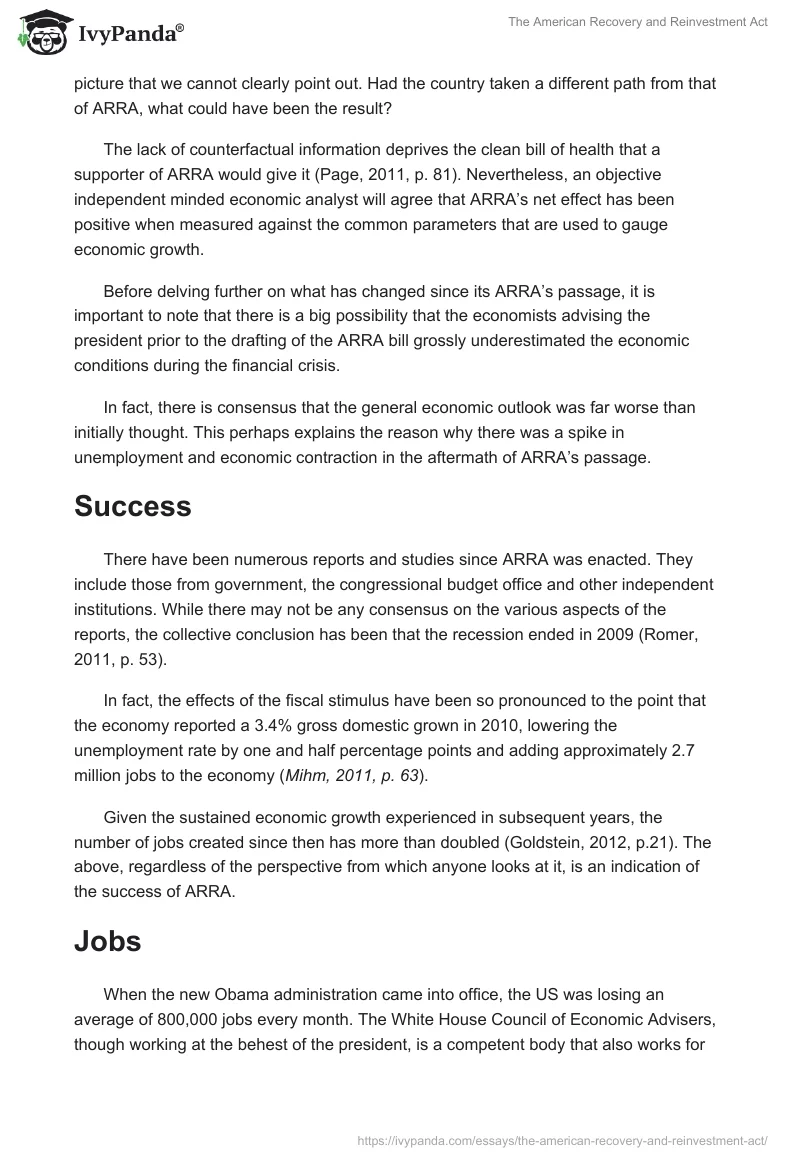Since the fall of the Soviet Union in the early 1990’s, the United States’ economic clout has been rising in an unprecedented rate, remaining virtually unchallenged till the late stages of the 21st century’s first decade.
The US’s financial system by virtual of its sophistication and size is the engine of the world economic system, a fact that was evident in the 2008 financial crisis and the subsequent recession that rippled through the world economic system.
In the wake of the crisis, the new administration of President Barrack Obama took over and continued economic resuscitation efforts started by former President Bush. Among the many initiatives undertaken by the current administration was the introduction of the American Recovery and Reinvestment Act (ARRA) that President Obama signed to law in 2009.
The stimulus package as it was popularly referred to was, mainly intended to stimulate the American economy through both individual and corporate tax breaks, advancement of employment benefits through expansion of the social welfare program and increased domestic spending mainly in infrastructure, energy, environment and research.
Since the enactment of the act, a lot has taken place economically and different economic experts differ whether or not the act achieved its targets. To arrive at a comprehensive conclusion with the above assertion in mind, it is important to examine closely the main objectives as they were outlined by President Obama and fellow Democrats when selling the idea to the public.
One of the objectives of the ARRA was to stop the recession through creation of jobs and to spur investment, effectively increasing output. Simple economics say that increased output can only be measured through overall gross domestic product growth.
Most of the arguments for or against the ARRA have been partisan, based on party lines. Regardless of what one feels about ARRA, there is one aspect of the whole picture that we cannot clearly point out. Had the country taken a different path from that of ARRA, what could have been the result?
The lack of counterfactual information deprives the clean bill of health that a supporter of ARRA would give it (Page, 2011, p. 81). Nevertheless, an objective independent minded economic analyst will agree that ARRA’s net effect has been positive when measured against the common parameters that are used to gauge economic growth.
Before delving further on what has changed since its ARRA’s passage, it is important to note that there is a big possibility that the economists advising the president prior to the drafting of the ARRA bill grossly underestimated the economic conditions during the financial crisis.
In fact, there is consensus that the general economic outlook was far worse than initially thought. This perhaps explains the reason why there was a spike in unemployment and economic contraction in the aftermath of ARRA’s passage.
Success
There have been numerous reports and studies since ARRA was enacted. They include those from government, the congressional budget office and other independent institutions. While there may not be any consensus on the various aspects of the reports, the collective conclusion has been that the recession ended in 2009 (Romer, 2011, p. 53).
In fact, the effects of the fiscal stimulus have been so pronounced to the point that the economy reported a 3.4% gross domestic grown in 2010, lowering the unemployment rate by one and half percentage points and adding approximately 2.7 million jobs to the economy (Mihm, 2011, p. 63).
Given the sustained economic growth experienced in subsequent years, the number of jobs created since then has more than doubled (Goldstein, 2012, p.21). The above, regardless of the perspective from which anyone looks at it, is an indication of the success of ARRA.
Jobs
When the new Obama administration came into office, the US was losing an average of 800,000 jobs every month. The White House Council of Economic Advisers, though working at the behest of the president, is a competent body that also works for the tax payer and has a duty to tell the truth to the people especially concerning the economic outlook.
By 2011 according to the council, ARRA had created or saved 3.6 million jobs (Goldstein, 2012, p.32). State governments had expanded their payrolls by almost 40,000 mainly through the stimulus funds they were receiving from government.
Though the unemployment rate was stubbornly high in the years leading to the 2012 election, it has since fallen to sustainable single digit levels, a move that has cast a positive outlook on the general employment situation. Economists suggest a job creation rate of over 225,000 to ensure sustainable growth.
Though the numbers have hardly reached that level consistently, every month since 2010 has seen positive job creation numbers a pointer to sustained economic growth momentum thanks to ARRA (Goldstein, 2012, p.35).
GDP expansion
Job creation and a consistently low unemployment rate are some of the major indicators of an economy in the right direction. Job growth is primarily determined by expansion of the gross domestic product. A contracting GDP indicates falling output, meaning less people are engaged in meaningful employment. That is what happened when President Obama took office in 2009.
Contraction of GDP continued till 2010 when it showed signs of recovery thanks to initiatives like ARRA. It is important to note that ARRA rode on a $ 787 billion bill.
This is a significant amount of money that when injected to the economy through increased spending on programs such as infrastructure and tax cuts creates real economic benefits. The net benefit when all factors are held constant is very significant and there is no doubt they were among the factors that propelled the economy out of the recession.
It therefore makes sense to argue that ARRA made it possible for the economy to expand sooner than projected.
Conclusion
As pointed out earlier, there is no telling what could have happened if the Obama administration had taken a different path in restoring the economy. However, it is also important to acknowledge that ARRA is the basis of the recovery and economic growth momentum that the country is experiencing at the moment.
Regardless of one’s political leaning, it is important to acknowledge the importance of the actions that the Obama administration took especially on the extension of aid by the federal government to the local and state authorities as well as through increased spending.
There is no doubt that more could have been done to pull the country out of the recession faster than it happened. In fact there is more that can be done to accelerate the economic recovery. However, credit has to be given to ARRA for providing the platform on which the current economic growth is riding on.
References
Goldstein, M. (2012). Recovery Act: Preliminary Observations on the Implementation. Los Angeles: Lippincot.
Mihm, C. (2011). Recovery Act: States’ and Localities’ Use of Funds. New York, NY: Diane Publshing.
Page, B (2011). Estimated Impact of the American Recovery and Reinvestment Act. New York, NY: Routledge.
Romer, C. (2011) Economic Impact of the American Recovery and Reinvestment Act. New York, NY: Penguin Books.


